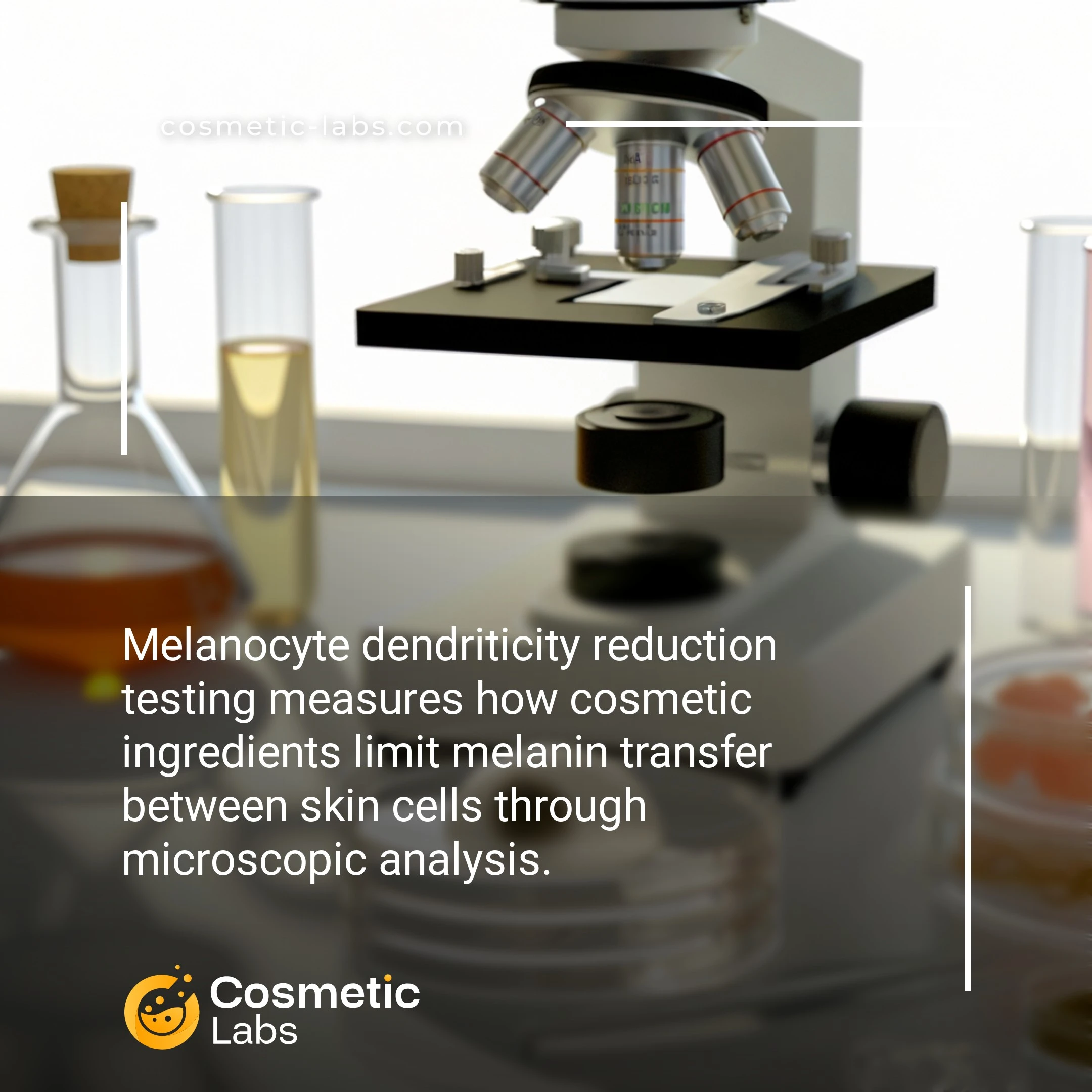Melanocyte Dendrite Reduction Testing for Skin Brightening

What is Melanocyte dendriticity reduction testing?
Melanocyte dendriticity reduction testing is a specialized assay that measures how cosmetic ingredients limit the branching extensions of pigment-producing cells. Our partner labs use in vitro melanocyte cultures to evaluate whether your whitening or brightening formulations can reduce dendritic processes by 20-40%, which directly correlates to decreased melanin transfer and visible skin lightening effects in finished products.
Why do you need this service?
Cosmetic labs use melanocyte dendrite reduction testing to validate brightening serums and spot treatments before market launch, measuring how active ingredients like kojic acid or arbutin actually reduce pigment transfer between skin cells. This testing helps brands prove their lightening claims with quantifiable data, supporting regulatory submissions and marketing campaigns with concrete efficacy percentages rather than theoretical promises.
Who provides Melanocyte dendriticity reduction testing services?
All cosmetic labs providing Melanocyte dendriticity reduction testing services
There is no company providing these services at the moment.
Melanocyte Dendrite Reduction Testing Services
Melanocyte dendrite reduction testing evaluates how effectively ingredients limit the branching extensions that transfer pigment to skin cells. This specialized assay complements broader pigmentation testing by focusing on the cellular mechanisms that control melanin distribution and skin tone evenness.
In Vitro Dendrite Morphology Analysis
Labs use advanced imaging systems to measure dendrite length, branching patterns, and contact points with keratinocytes. Testing typically involves treating melanocyte cultures with your active ingredients at various concentrations over 72-96 hours.
Key measurements include:
- Average dendrite length reduction (typically 20-40% for effective compounds)
- Branch point quantification
- Cell viability assessment to confirm non-toxic effects
- Dose-response curves for optimal formulation guidance
Mechanism-Specific Pathway Testing
Advanced testing examines how ingredients affect specific proteins that regulate dendrite formation, including Rac1, CDC42, and cytoskeletal components. Labs can test individual pathways or run comprehensive panels to understand your ingredient’s complete mode of action.
This data helps position your product claims around targeted skin brightening rather than general lightening effects. Results support regulatory submissions and provide the scientific backing needed for premium positioning in competitive markets.
Connect with specialized labs on our platform to discuss your dendrite reduction testing requirements and timeline expectations.
Practical Applications of Melanocyte Dendrite Reduction Testing
Cosmetic labs use melanocyte dendriticity reduction testing to validate active ingredients and formulations that target hyperpigmentation and uneven skin tone across multiple product categories.
Anti-Aging and Brightening Product Development
Labs evaluate how ingredients like kojic acid, arbutin, and vitamin C derivatives affect dendrite formation in melanocytes. Testing protocols measure dendrite length reduction over 24-72 hour periods using fluorescence microscopy. Quantitative analysis shows percentage reductions in dendrite complexity, helping brands optimize concentrations for serums and creams.
Product developers use these results to support claims about skin brightening efficacy. Testing data guides formulation adjustments and provides documentation for regulatory submissions in markets requiring efficacy proof.
Targeted Spot Treatment Formulations
Specialized testing evaluates concentrated actives designed for dark spot correction. Labs test ingredients like hydroquinone alternatives, licorice extract, and peptide complexes at higher concentrations than typical face products. Dose-response curves determine optimal active levels that reduce dendrite formation without causing cytotoxicity.
Results inform product positioning and usage instructions. Brands use dendrite reduction percentages to differentiate spot treatments from general brightening products and justify premium pricing for targeted solutions.
| Testing Parameter | Measurement Method | Typical Results |
|---|---|---|
| Dendrite Length | Fluorescence microscopy | 20-60% reduction |
| Dendrite Complexity | Morphometric analysis | 15-45% decrease |
| Cell Viability | MTT assay | >80% maintained |
| Testing Duration | Time-course study | 24-72 hours |
Contact labs on our platform to discuss melanocyte dendriticity testing protocols for your specific formulation needs and regulatory requirements.
